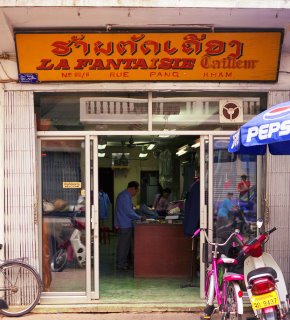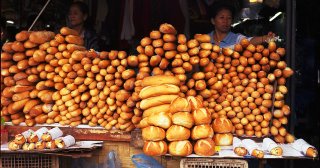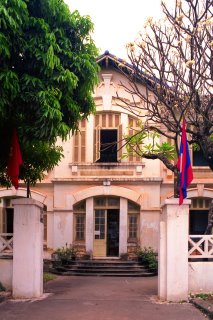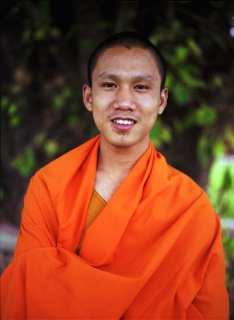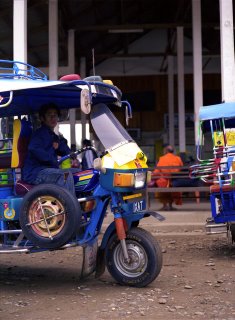
Welcome to Luang Prabang's dusty bus station. It's a very short ride into town and even though April is the start of the low season, the first two guest houses we hit were full. Makes you realize it's probably a very good idea to make reservations during the high-season. Our third guesthouse (Chantanome Guesthouse, +856+030-5140633, US$10/night) had a charming wood-panelled room with private bathroom that we took immediately.

No we didn't get much sleep on the bus but we still hit the streets as soon as we'd had cheese, baguette, coffee, eggs, and bacon. By then, kids where going to school. It was the last of them I saw, in uniform, so it must have been the last day of school before the New Year break. Just like Thailand, Laos' summer heat reaches its peak mid-April and the lunar year begins aknew around April 14th with week-long celebrations that include gigantic nation-wide water wars in the streets. As a sidenote, I just celebrated this in Bang Saen, Thailand, and you must imagine kilometers of traffic-jammed pick-ups loaded with huge tubs of water, everybody throwing that around with guns or simple bowls, and smearing each other's faces with talcum powder. Apparently Luang Prabang is the place to be for the "Pee Mai' in Laos(which means New Year, just like in Thai, but Thais call it Songkran). I can believe that because on the last day we were there, still 11 days from the three official days between April 13 to 15, people began throwing water! In Thailand, you can judge the intensity of Songkran fever in a particular place by how early it starts and how long it lasts (a mere two days in Phuket, weeks in Chiang Mai) but I never heard of anyone starting April 2!
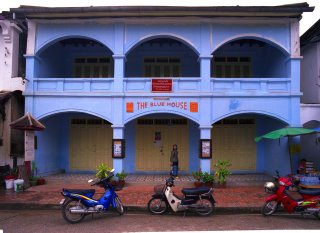
The Blue House, Th Sisavangvong.
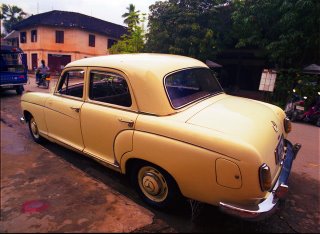
The Car from Naga Guesthouse, Th Sisavangvong.
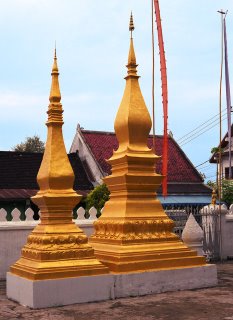
Stuppas at Wat Saen, Th Sisavangvong.
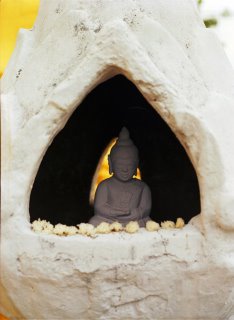
Buddha in lotus flower, Wat Saen, Th Sisavangvong.
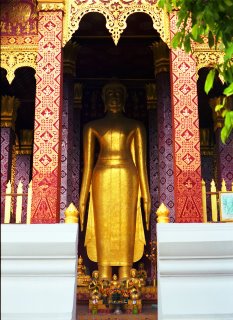
Standing golden Buddha, Wat Saen, Th Sisavangvong.

One of the many upscale restaurants in Luang Prabang and its "falang" owner, Th Sisavangvong.
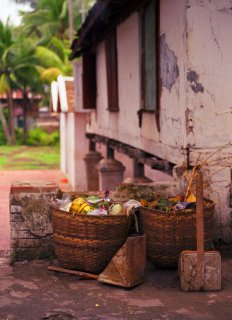
Whicker garbage cans and half-jerrycan dust trays, Th Sisavangvong.

This lion looks like a messy eater but for having seen how the novice monks do their painting chores, the red paint on this little fellow is still pretty neatly applied.
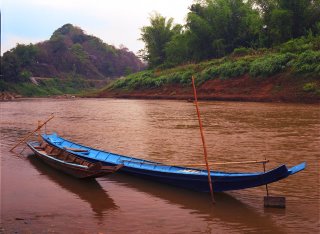
Fishing boat on Nam Khan, an affluent of the Mekong that runs on the South-Eastern side of Luang Prabang before meeting the Mekong at its northernmost tip. Nam Khan and the Mekong give Luang Prabang its peninsular shape and that very special feeling that comes from being in sight of water at all times.

The temple on the Royal Palace grounds that contains the Pha Bang, a standing Buddha of gold after which Luang Prabang is named.
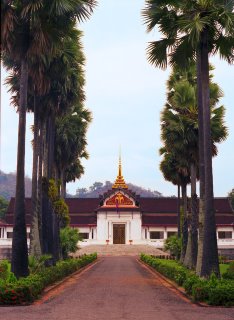
This very blunt shot of the palace does nothing to render the beauty of the place. The museum (no pictures allowed) it contains is exceptional as well. It contains religious sculptures and objects belonging to the royal family of Laos or their retainers. Some of its rooms are still as they would have been when the palace was inhabited. Between it and the mountain that serves as its backdrop on this picture lies the Mekong while Phu Si mountain is behind us. The last of the royal family disapeared in 1975 in Northern Laos.
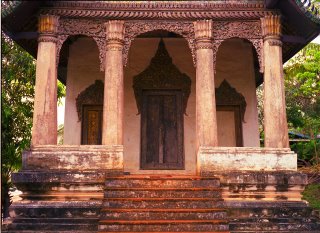
Wat Pha Huak, across from the Royal Palace, at the foot of Phu Si.

The gardeners are kind enough to trim the trees so that every tourist who comes to Luang Prabang can take the same shot of the Royal Palace from the top of Phu Si mountain, beneath the stupa of That Chomsi.
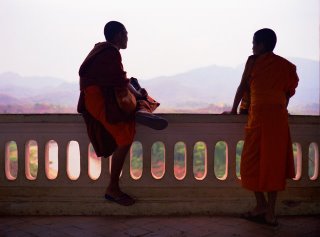
Two novice monks overlook the Mekong from the top of Phu Si mountain, at Wat Tham Phu Si, next to a small cave where one can see an imprint of the Buddha's foot. Once I looked at the picture I had to wince. Taking pictures really makes a rushed Japanese tourist of you. When this picture came up from the scanner onto my screen, it struck me what a stunningly beautiful and calm place to be this mountaintop must have been. Unfortunately, I remember only wondering how I could ever fit such a wide range of light and dark in one picture. The answer is low contrast Fuji 160S negative film by the way and a pretty lucky exposure setting. Come to think of it, the most fun I had on this trip was after I smashed my camera! But this kind of picture--even if it's an insult to the rule of thirds--makes it all worth it because it's a magic moment captured for eternity.
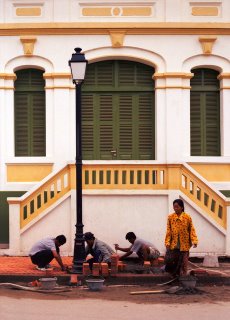
There is a lot of restoration work going on in Luang Prabang, particularly on the sidewalks while we were there. They are all made of diagonally interlocking bricks and visibly this is true to tradition as I could see the same brick motif under peeling tar on yet unrestored streets. This work is financed by the UNESCO and the Agence Francaise pour le Development. Every bit of construction has its sign reading who paid for it (the two I have just named) and how much it costs; usually around one to two thousand US dollars.

Senior monk and his novices at Wat Pha Phuttabaht. On top of the considerable investments made by the UNESCO to restore his temple, this monk also has his novices working hard to upkeep the place. He kindly showed us around the temple and told us about this past studies in Chiang Mai (Thailand). The UNESCO also has a school in Luang Prabang to train skilled laborers in the restoration and preservation of Luang Prabang's past.
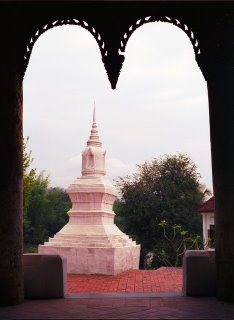
View from inside Wat Pha Phuttabaht.

Old colonial home on Th Sisavang Vathana.
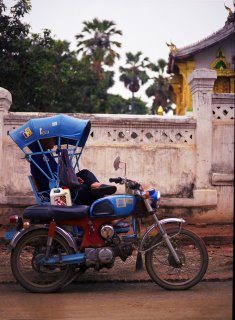
On the street along the Royal Palace that goes down to the pier on the Mekong.
That's all for today. Day 4 takes us an hour's boat ride down the Mekong to a cave overlooking its waters that is crammed with Buddhas and then 25km out of town to the milky turquoise waters at the foot of a giant waterfall.
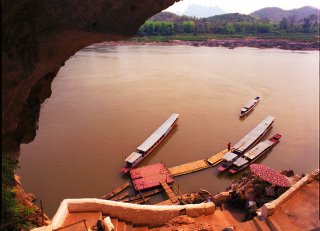 Day 4 takes us to the Buddha caves of Pak Ou. I don’t like traveling as part of a group but for the two most popular half-day trips out of Luang Prabang, it would be rather expensive to rent your own boat (for Pak Ou) and mini-van (for the afternoon at Kuang Si waterfalls). The 2 trips cost the assistant and I a grand total of 14 dollars; a slight discount off the price for individual travelers or people going only to either Pak Ou or Kuang Si.
Day 4 takes us to the Buddha caves of Pak Ou. I don’t like traveling as part of a group but for the two most popular half-day trips out of Luang Prabang, it would be rather expensive to rent your own boat (for Pak Ou) and mini-van (for the afternoon at Kuang Si waterfalls). The 2 trips cost the assistant and I a grand total of 14 dollars; a slight discount off the price for individual travelers or people going only to either Pak Ou or Kuang Si. Pak Ou is an hour’s boat ride along the Mekong from Luang Prabang. I’d done a trip of similar length at the Golden Triangle (for maybe five times the price) and my impression was confirmed—boat trips on the Mekong are not very exciting. The backpackers I met on the boat who had done 2-day cruises (coming from Chiang Mai, Thailand for example) said those were just as boring, only much longer. Still, you have to ride the Mekong at least once in a lifetime. Around Luang Prabang, the river reminded me of the Lijiang, when it runs through Guilin, in China, except without the dramatic mountainous backdrop that has made Guilin world-famous.
Pak Ou is an hour’s boat ride along the Mekong from Luang Prabang. I’d done a trip of similar length at the Golden Triangle (for maybe five times the price) and my impression was confirmed—boat trips on the Mekong are not very exciting. The backpackers I met on the boat who had done 2-day cruises (coming from Chiang Mai, Thailand for example) said those were just as boring, only much longer. Still, you have to ride the Mekong at least once in a lifetime. Around Luang Prabang, the river reminded me of the Lijiang, when it runs through Guilin, in China, except without the dramatic mountainous backdrop that has made Guilin world-famous.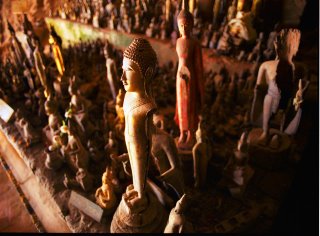 Being on a group trip, I’d spent an hour in the morning waiting for the organizers to pack their boat to its full capacity, racing back and forth to get people out of bed or from their guesthouse to the landing. When we did make it to Pak Ou, we were told we had only twenty minutes. This was more than enough for the American family, the backpackers, and the Israeli couple that were sharing our boat but you don’t have all my pictures here and you have to realize they’re all tripod shots that take a long time to set up; so it wasn’t enough time for me. My take on it was that they could all screw themselves and wait while I did my stuff since I’d waited for them so long in the morning. I still had to run like a madman the flight of steps that takes you from the lower cave (cramped with small Buddha images) to the upper cave (with the giant golden Buddha at its door). In the end, I got all I wanted and even two shots I wouldn’t have dared hope for as the boat pulled out because they were without tripod and the light was set on the fly (the man in his boat and the general view of cave).
Being on a group trip, I’d spent an hour in the morning waiting for the organizers to pack their boat to its full capacity, racing back and forth to get people out of bed or from their guesthouse to the landing. When we did make it to Pak Ou, we were told we had only twenty minutes. This was more than enough for the American family, the backpackers, and the Israeli couple that were sharing our boat but you don’t have all my pictures here and you have to realize they’re all tripod shots that take a long time to set up; so it wasn’t enough time for me. My take on it was that they could all screw themselves and wait while I did my stuff since I’d waited for them so long in the morning. I still had to run like a madman the flight of steps that takes you from the lower cave (cramped with small Buddha images) to the upper cave (with the giant golden Buddha at its door). In the end, I got all I wanted and even two shots I wouldn’t have dared hope for as the boat pulled out because they were without tripod and the light was set on the fly (the man in his boat and the general view of cave).
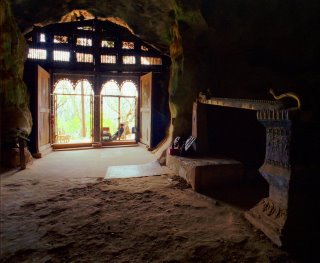
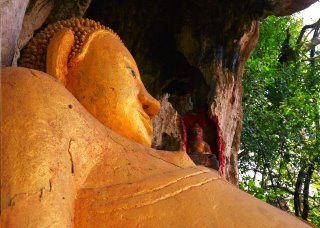
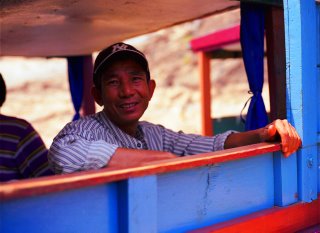
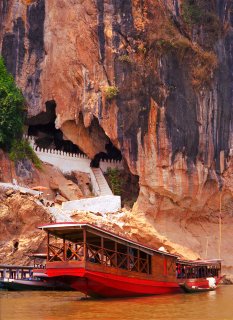
 Some people will outright discourage you to even make the trip to Pak Ou, because of the length of the boat ride and because you might have seen other Buddha Caves in South-East Asia that rival Pak Ou. Also, the boats will stop in two villages on the way back. You know the drill; these places are basically villages turned open-air shopping malls where the locals get a chance to sell you their handicraft. Still, the development of tourism in Laos means these villages are nowhere near what you might have seen elsewhere. No buses stop here for one. The first village sells rice alcohol “Lao Lao” and the second one paper and textiles.
Some people will outright discourage you to even make the trip to Pak Ou, because of the length of the boat ride and because you might have seen other Buddha Caves in South-East Asia that rival Pak Ou. Also, the boats will stop in two villages on the way back. You know the drill; these places are basically villages turned open-air shopping malls where the locals get a chance to sell you their handicraft. Still, the development of tourism in Laos means these villages are nowhere near what you might have seen elsewhere. No buses stop here for one. The first village sells rice alcohol “Lao Lao” and the second one paper and textiles.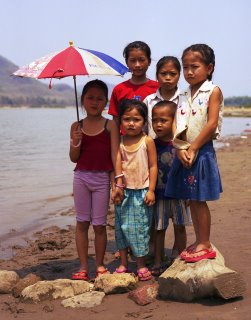 If you don’t have the time or desire to go on several-day treks deep into the jungle, these are a chance to see a village, albeit richer and more developed than the ones further off the beaten track. I’ll always take “off the beaten track” over “group tour” but let’s not get fascistic about it. These are villages, with real homes containing real people that sell stuff they really made. It’s not “Disneyland” as people like to call anything that doesn’t take a three-day hike to get to. No, you’re not going to “truly meet and exchange” with the locals as the stops are about 10-minutes. But I’m very dubious of how much more you can exchange when sleeping in a hill-tribe village overnight when you don’t speak their language. Think of how many people you’ve truly met in your city or town where you’ve lived for years and share the same culture and language. Ok, this is starting to sound like a rant. NEXT.
If you don’t have the time or desire to go on several-day treks deep into the jungle, these are a chance to see a village, albeit richer and more developed than the ones further off the beaten track. I’ll always take “off the beaten track” over “group tour” but let’s not get fascistic about it. These are villages, with real homes containing real people that sell stuff they really made. It’s not “Disneyland” as people like to call anything that doesn’t take a three-day hike to get to. No, you’re not going to “truly meet and exchange” with the locals as the stops are about 10-minutes. But I’m very dubious of how much more you can exchange when sleeping in a hill-tribe village overnight when you don’t speak their language. Think of how many people you’ve truly met in your city or town where you’ve lived for years and share the same culture and language. Ok, this is starting to sound like a rant. NEXT. Monk's quarters at the "Paper" village. See, they have electricity! We shouldn't have gone.
Monk's quarters at the "Paper" village. See, they have electricity! We shouldn't have gone. It’s a rough ride to Kuang Si waterfalls and the amount of people they horn-shoe into those minivans is simply ridiculous. The legroom is more than enough for any six-year-old. Everybody else will have to figure out whichever Yoga position is less painful to him or her. It’s only 20 or so kilometers but you already know the 380 kilometer stretch from Vientiane to Luang Prabang took 10 hours so don’t look at the kilometers, they mean nothing. Lunch there was a rip-off—about 300 baht for somtam, sticky rice, and grilled chicken, a price I’ve yet to see even in Bangkok—but it was soon all worth it. The restaurant’s cats, though, were so disgustingly cute, I decided to waste a picture on them.
It’s a rough ride to Kuang Si waterfalls and the amount of people they horn-shoe into those minivans is simply ridiculous. The legroom is more than enough for any six-year-old. Everybody else will have to figure out whichever Yoga position is less painful to him or her. It’s only 20 or so kilometers but you already know the 380 kilometer stretch from Vientiane to Luang Prabang took 10 hours so don’t look at the kilometers, they mean nothing. Lunch there was a rip-off—about 300 baht for somtam, sticky rice, and grilled chicken, a price I’ve yet to see even in Bangkok—but it was soon all worth it. The restaurant’s cats, though, were so disgustingly cute, I decided to waste a picture on them. 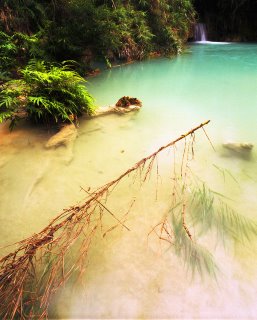 The color of the water in Kuang Si’s multiple pools is milky turquoise. It’s very fresh which is exactly what you want on a sunny day in SE Asia. This stop was 2-hours so I had time to both play in the pools and take pictures. You have to walk around a bit at Kuang Si because I almost missed the big waterfall while some people at the big waterfall missed the smaller “swimming pools” beneath it. Kuang Si is really magical and a lot of fun. I even had one pool all to myself for most of the time.
The color of the water in Kuang Si’s multiple pools is milky turquoise. It’s very fresh which is exactly what you want on a sunny day in SE Asia. This stop was 2-hours so I had time to both play in the pools and take pictures. You have to walk around a bit at Kuang Si because I almost missed the big waterfall while some people at the big waterfall missed the smaller “swimming pools” beneath it. Kuang Si is really magical and a lot of fun. I even had one pool all to myself for most of the time.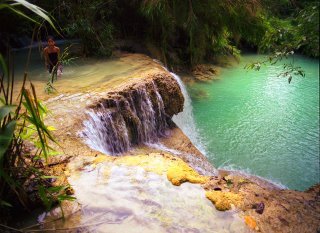
 I’m including these two shots because I personally love “with or without” or “before and after” shots to explain a photographic technique. Most people just tell you what to do and show you the result without showing you what their picture would be like if they hadn’t done whatever it is they’re suggesting. As I set up this shot, this Lao girl stepped into the pool. I decided to take the picture even though I hadn’t screwed on my polarizing filter yet. Look at the foreground on her picture; it is a slab of white light. Now if you look at the picture without her, you can see through the water to the rock and it’s much more interesting. The lower pool has also fewer reflections. Notice also that another effect of the polarizer is that you need to slow down your shutter speed a lot since it “eats up” a lot of light. This makes the water much creamier. It’s a matter of taste but for shots of water splashing over rocks (beachsides, waterfalls), this effect is usually highly desired. A neutral density filter could have allowed me to slow the shutter speed down even more but past a second or two, I don’t think it would have made much of a distance. On a wave-beaten shore, very long exposures (1 minute) can give the impression of mist on the water though. Look at the timecatcher.com in my links for examples of this.
I’m including these two shots because I personally love “with or without” or “before and after” shots to explain a photographic technique. Most people just tell you what to do and show you the result without showing you what their picture would be like if they hadn’t done whatever it is they’re suggesting. As I set up this shot, this Lao girl stepped into the pool. I decided to take the picture even though I hadn’t screwed on my polarizing filter yet. Look at the foreground on her picture; it is a slab of white light. Now if you look at the picture without her, you can see through the water to the rock and it’s much more interesting. The lower pool has also fewer reflections. Notice also that another effect of the polarizer is that you need to slow down your shutter speed a lot since it “eats up” a lot of light. This makes the water much creamier. It’s a matter of taste but for shots of water splashing over rocks (beachsides, waterfalls), this effect is usually highly desired. A neutral density filter could have allowed me to slow the shutter speed down even more but past a second or two, I don’t think it would have made much of a distance. On a wave-beaten shore, very long exposures (1 minute) can give the impression of mist on the water though. Look at the timecatcher.com in my links for examples of this.
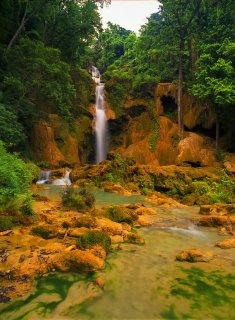
 Jungles are beautiful. Just point and shoot.
Jungles are beautiful. Just point and shoot. Of course, I was the last one on the minibus, again. It stopped in another village on the way back where I took this shot.
Of course, I was the last one on the minibus, again. It stopped in another village on the way back where I took this shot. The sun was setting on the Mekong by the time we returned to Luang Prabang. We walked down to the shore where a man was fishing with a net strewn between two long bamboo polls as children watched on.
The sun was setting on the Mekong by the time we returned to Luang Prabang. We walked down to the shore where a man was fishing with a net strewn between two long bamboo polls as children watched on.
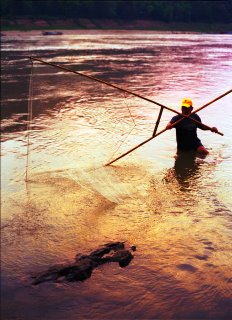

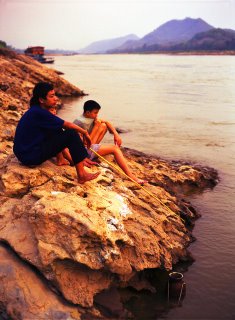
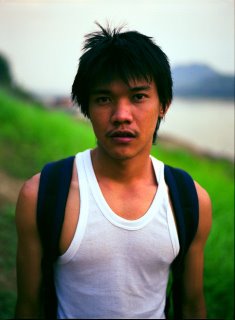 The assistant, after a long day’s work.
The assistant, after a long day’s work.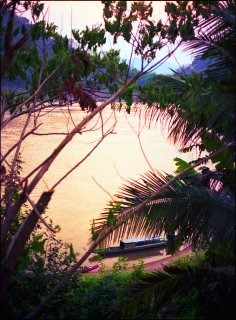 Back on Th Khem Khong, a last glimpse of the Mekong.
Back on Th Khem Khong, a last glimpse of the Mekong.





















